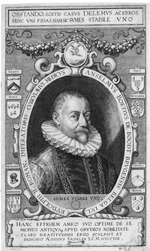Anselmus de Boodt
| Anselmus de Boodt | |
|---|---|
 |
|
| Born | 1550, Bruges |
| Died | 1632, Bruges |
| Nationality | Flemish |
| Fields | mineralogist, physician, naturalist, writer, draughtsman |
Anselmus de Boodt or Anselmus Boëtius de Boodt (Bruges, 1550 - Bruges, 21 June 1632) was a Flemish humanist, mineralogist, physician and naturalist. Along with the German known as Georgius Agricola, de Boodt was responsible for establishing modern mineralogy. De Boodt was an avid mineral collector who travelled widely to various mining regions in Germany, Bohemia and Silesia to collect samples. His definitive work on the subject was the Gemmarum et Lapidum Historia (1609).
De Boodt was also a gifted draughtsman who made many natural history illustrations and developed a natural history taxonomy.
De Boodt descended from an family. His ancestors had come from Dortrecht in the 13th century. His father Anselmus de Boodt (1519-1587) was a renowned broker who also provided overseas insurance coverage.
De Boodt studied artes at the University of Louvain. He left to study canonical and civil law at the University of Orléans from the end of 1572. After completing his studies, he went to study for a while in Padua where his presence is confirmed in 1576. In 1579 he was appointed to the city council of Bruges and was involved in the financial administration of the city of Bruges. However, he had to leave the city after the Calvinists took power.
De Boodt went to Bohemia where in 1583 he was appointed the personal physician of Wilhelm Rosenberg, an important diplomat and military leader of Bohemia, who lived in the Renaissance Castle of Český Krumlov in southern Bohemia. During his stay at the court of Rosenberg, he likely studied medicine at Heidelberg where he met the Swiss doctor of medicine Thomas Erastus.
...
Wikipedia
